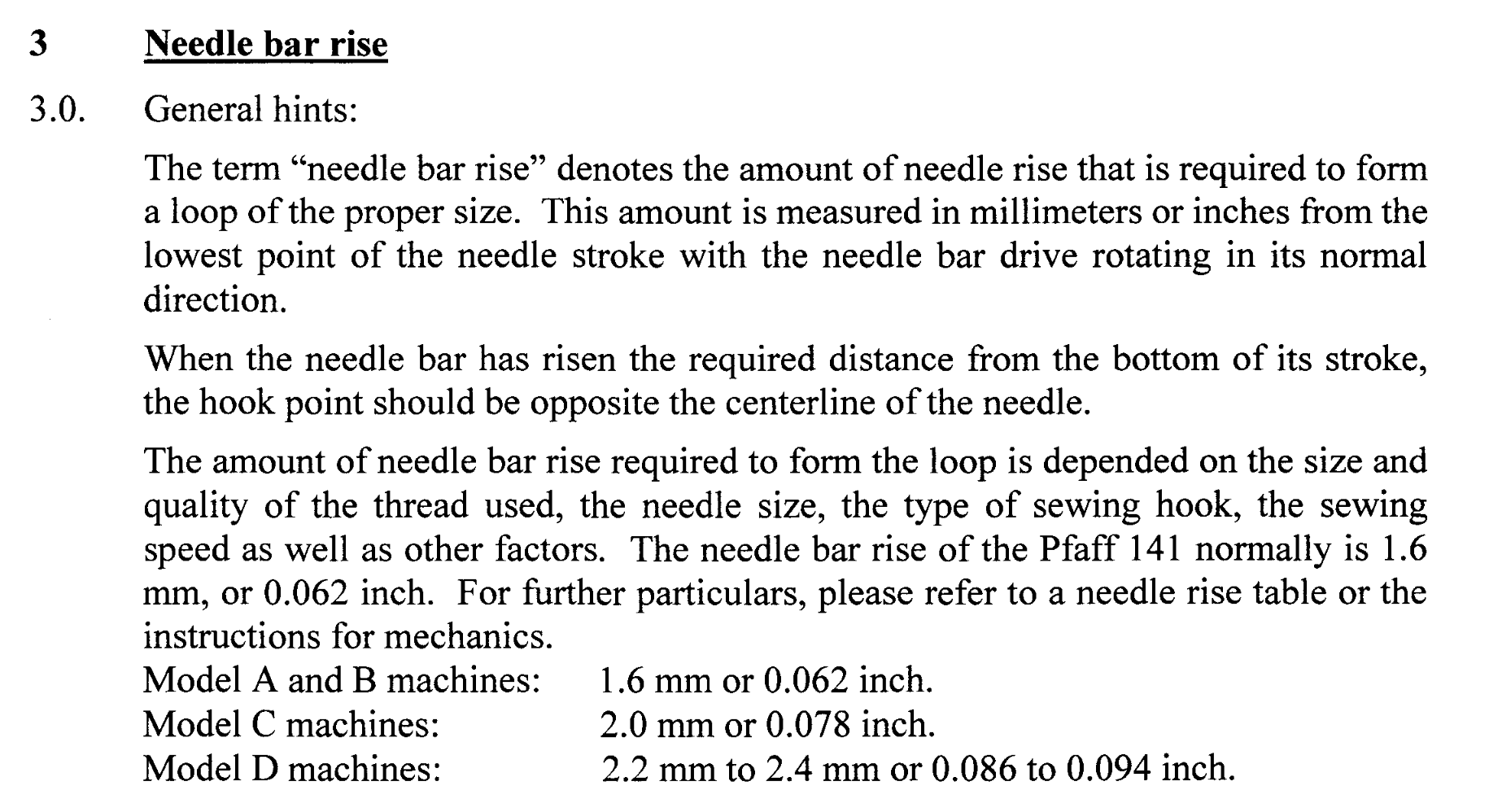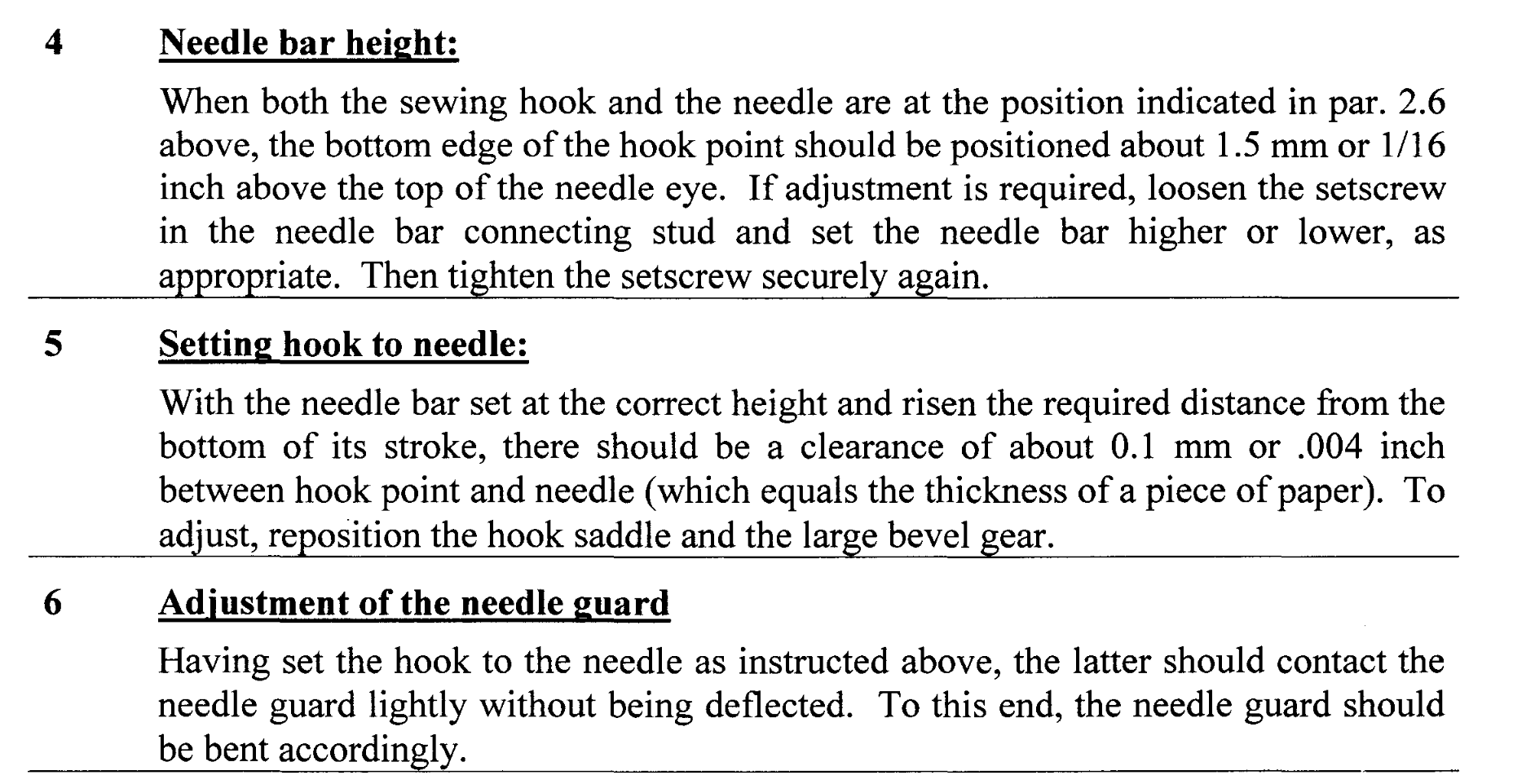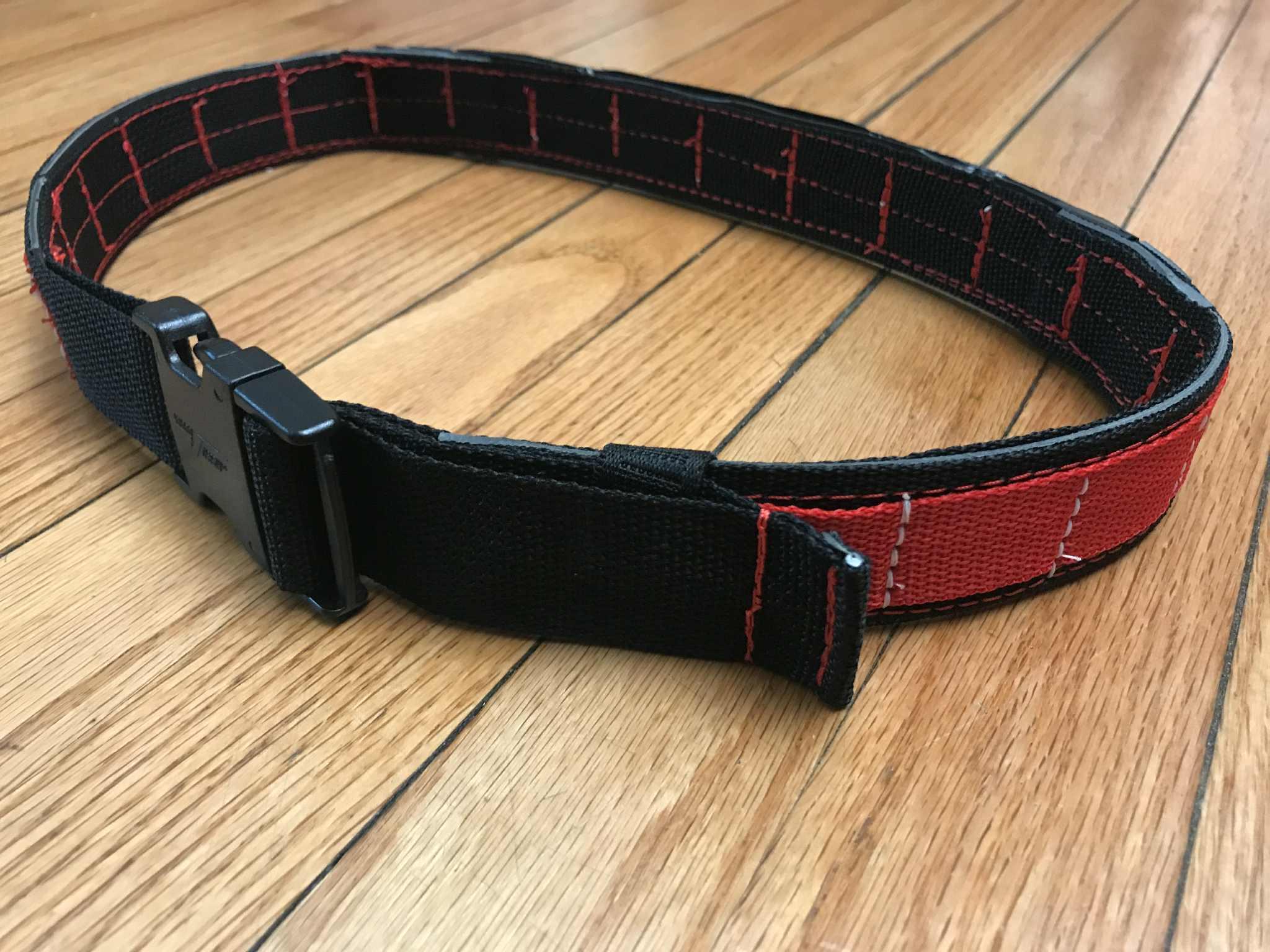-
Posts
420 -
Joined
-
Last visited
Content Type
Profiles
Forums
Events
Blogs
Gallery
Everything posted by friquant
-

Singer 111w155 stitch length issues
friquant replied to Glaciersew's topic in Leather Sewing Machines
Clarifying here...are you able to adjust the stitch length? Meaning can you adjust to go smaller than 6/in ? When making the adjustment toward longer stitches, does the adjustment screw stop? When your needle lands on the material, what is the motion of the feed dog? Ideally the feed dog is stopped front to back motion when the needle lands. Just wondering if you are losing some traction by something else being out of time. Perhaps a video of your feed dogs working, and photos of your stitch length regulator? -

Frozen Stitch Length on Singer 144W103
friquant replied to friquant's topic in Leather Sewing Machines
It's getting better! When I got the machine it stitched 8mm stitches. After the first round of diesel it was adjustable from 8mm - 12mm. I'm guessing that 12mm is the maximum for this machine since it seems to come to hard stop there, and it's a "round number". A week or so later I tried again and now it adjusts down to 6mm! Guess I'll keep soaking it as I use it to see if it will keep freeing up. If I can get it down to 3mm that's probably good enough. I appreciate the help -

Hook to Needle Distance: A Compromise
friquant replied to friquant's topic in Leather Sewing Machines
I finally came across an old post by gottaknow where he shows us the answer to my question above, "How to always have the hook to needle distance be next to nothing?" https://leatherworker.net/forum/topic/47477-211g155-do-i-have-the-wrong-machine/page/6/#findComment-304044 -

Singer 211 U166A walking foot problem
friquant replied to NowhereMan01's topic in Leather Sewing Machines
That's great! Ideally the safety clutch would trip before the belt slips, so on some cold October night you may want to investigate how to get the safety clutch to disengage under load. Figure 65 (page 26) shows a style of safety clutch that is unfamiliar to me. I think you adjust those three screws coming out the side to set how easily the clutch trips. -
The heel on the machine pedal is typically used to bring the needle up. It still stitches in the forward direction (about half a machine revolution) to bring the needle up. And it only works if you are both using a needle positioner and have stopped with the needle down. That is, you sew along, then release the pedal, and the machine keeps moving until it reaches needle-down, then stops. At that point, you tap the heel and the machine moves (forward) to needle-up. UPDATE Looking at the manual, I see these two options: P-I "Reverse After Pedal Heel Down" P-JJ "Setting of reversing angle" This sounds to me like it's supposed to run the motor in reverse for a finite distance upon heel-tap. I'm not sure what the use case would be. Settings Can you tell us your settings for the following menu items? P-8 : Single signal synchronizer P-I : Reverse after heel pedal down P-J : Setting of reverse angle P-K : Needle up after pedal heel down P-Z : Select machine code
-

Singer 211 U166A walking foot problem
friquant replied to NowhereMan01's topic in Leather Sewing Machines
that's good! Just wanted to check that the middle foot had not been disconnected from the driving apparati. Here's what I would check, in this order. Page 13, "Reengage safety clutch". It's typical when the bobbin binds up for the safety clutch to trip. Make sure it's reengaged. Page 13 "Reverse Feed Mechanism". You mentioned a screw came off. I would inspect the reverse feed to make sure all the parts are in place and moving properly. Page 26, "Replacement of Arm Shaft Connection Belt". You don't need to remove the belt, but follow the instructions for verifying that the arm shaft (the one that the hand wheel bolts to) is in time with the hook shaft. Page 24, "Feed Eccentric Adjustment". You need to get the feed dog so that it halfway through it's fore-aft stroke when the needle is at bottom dead center. Page 23 and 24, "Feed Dog Adjustment". You want the feed dog to be at its highest point when the needle is at bottom dead center Page 25, "Lifting Eccentric and Alternating Presser Feet". -

Singer 211 U166A walking foot problem
friquant replied to NowhereMan01's topic in Leather Sewing Machines
Can the middle walking foot be raised by hand (with motor unplugged)? Looks like the feed dog timing is also off. (Normally needle would be at bottom dead center, and the feed dog at maximum height, when the feed dog is halfway through its front to back stroke.) Do you have a manual? -

Leather sewing machine for beginner beginners
friquant replied to girlscout4's topic in Leather Sewing Machines
Can we get pictures of the belts? I've never made a belt myself. I'm guessing you stitch through four layers total to attach the buckle. -
@nejcek74 I think the needle bar clamp question is for you ^^
-
Hi Guell, I took the end cap off my cylinder bed (different brand) , but mine looks different than yours. mine does not flop around like that, and the flopping seems detrimental to the feed actually working. What I would do is first remove the slotted / hex screw which will allow the feed dog to be removed. this will gain you additional visibility and hopefully it will become more obvious what should be preventing the flop. Taking pictures as you go will help you get it back together once you've solved the mystery. Good luck! Post some pictures of your progress if you don't mind
-
Has anything changed about your setup (needle size, thread size, leather thickness)? Have you rethreaded the top thread to verify that the path is correct? Would you be willing to measure the top and bottom tensions and report back?
-
It will be the first character on the second line of the brass plate on the front of the machine. Mine said: 545-H4-6/01 CLPMN So mine was a "C". This introduction to the pfaff numbering system explains what all the characters mean: https://leatherworker.net/forum/applications/core/interface/file/attachment.php?id=166325
-
Yes I have that one. Here’s the exact problem I’m having, not having the measurement of the standard needle bar height for the 545 and trying to use the 1245 manual which says 15mm for the standard position before fine tuning. But I can’t find the measurement in my 545 instruction manual or my 145 instruction manual. If you are still looking for how much needle bar rise, these excerpts from pages 3 and 4 of the supplement may be useful. page 3: Page 4:
-
Have you tried this manual, which has a supplement at the end? https://leatherworker.net/forum/applications/core/interface/file/attachment.php?id=172342 Anything in particular you are looking for?
-

Pfaff 346-H2 won't pick up bobbin thread.
friquant replied to GPD's topic in Leather Sewing Machines
Double needle...nice! You can pull the cover off the backside near the hook, and put one of these endoscopes down there and see what's happening: https://www.amazon.com/dp/B0CKQH4VZY Then with a brand new needle in the machine (scarf on the hook side), and the machine threaded, put a piece of fabric or leather under the foot and turn the machine over slowly with the handwheel while you watch the (cell-phone screen of the) boroscope. Ideally, the needle goes down and stops. Then it starts to come up and forms a loop. And the hook comes by at about the middle of the scarf and grabs the loop and takes it around the bobbin. Watching it zoomed in like that will show you what's happening. . It may also help to draw a black mark at about the middle of the scarf as a reference point for where the hook will come by. Maybe the hook is arriving at the wrong time. Maybe the hook is too far away from the needle. Maybe no loop is being formed. Maybe the hook point is very dull If the hook bushings are worn, you may need to adjust the hook closer to the needle to make sure it all but contacts the needle when you actually sew. If the hook point is worn to where it is no longer sharp, you can inspect this and possibly re-sharpen if it's not too bad. -

Review of Jianglong 341 after 4 months
friquant replied to friquant's topic in Leather Sewing Machines
Checked tonight for a second spot to attach the return spring. I don't see one. I did try turning the attachment point around, which almost works but then one of the levers bumps into it when you select long reverse stitches. I'd like to replace the factory spring with one that has less stiffness, but I haven't been to a hardware store in a while. Maybe it's time to start forming my own springs.. It only engageswhen I want to wind a bobbin. I wrote that part a couple months ago, and it actually hasn't bothered me since 😀 And I actually use the winder more than I used to. That is, when I think of it and when I think I might be using the same color bobbin thread for a while. I switch colors a lot.. I looked at this tonight. I don't see a good option outside of making my own label for the knob. Or drilling a new hold for the pin that acts as the final stop for the knob. I'm setting it so that the stitch length goes to zero as the pin runs into the final stop. I suppose instead I could figure out where a 4mm stitch is and line the knob up at the 4. 🤔 Ok. Seems reliable with a round eyelet. I can see benefits both ways. Here is the hook assembly. I assume this is NOT the singer 111 style. I wonder if the singer style has a larger outer hook diameter.. -
Was planning to keep it intact, and just tape the thread to the top plate for measurement. But when I took it apart to disable the Mode button (so it will always stay set to grams), it looked so easy to repurpose... kitchen-scale.mp4 Here's a link to the original 500g kitchen scale I bought. And a screenshot: Drilled two holes in the upper right and reused the original screws to mount the load cell there. Added hot glue to keep the wires from being damaged from being tossed around Taped over the digits to the right of the decimal place so they don't distract. Some other posts regarding measuring bobbin tension: gymnast uses a dynamometer RockyAussie measures with hammers Why measure? Because we like numbers 😃 gymnast: how much bobbin tension?
-
Review of Jianglong 341 purchased March 2025 I am quite happy with my Jianglong 341. It only took two months to get it, cost me a total of $1115 with a table, knee lift, foot lift, flatbed table attachment, servo motor, needle positioner, and a couple of binding attachments. It’s been quite versatile. I’ve been able to stitch a stack of vinyl 12mm high using TEX 270 thread. I’ve also been able to repair my watchband with TEX 70 thread. Not that I expect it to be exactly as good as an original Juki 341, but in areas where it is a little less polished, I have been able to adapt. First Impressions On arrival it sewed well. It stitched slightly longer stitches in reverse than in forward. I would say it was not perfectly in adjustment, but I had no complaints about it at the time. Here is my “first impressions” forum post: https://leatherworker.net/forum/topic/125619-jianglong-341-first-impressions/ Representative Work Here are some photos representative of things that I stitch. On the left is a tote with liner and heavy interfacing in the base. In the middle is a backpack compartment that uses plastic corrugated signboard for two of its interior walls. On the right is a heavy belt made of webbing on the outside and a plastic core for stiffness. Thread Size Supposedly this machine is rated up to TEX 207. I’ve used TEX 30 on up to UNbonded TEX 270. Mind you, I’m mostly sewing textiles so I can’t vouch for its abilities with large thread going through thick stacks of leather. Major Quibbles after Four Months of Use Here are the main things that I hope Jianglong will correct in the future. 1. No Hook Safety Mechanism The juki 341 manual shows a hook safety mechanism, but the Jianglong 341 has none. (You can run low belt tension to help keep you from damaging) 2. Advertised Stitch Length The factory advertises 9.5mm stitch length. This is only achievable if you optimize for forward stitch length, leaving your reverse stitches about 3mm long. If you balance the stitch length, you can get 8mm forward and reverse. 3. Banana Slide The arm that connects to the banana slide is too long in my opinion. What this means is that when you adjust the height of the walking feet, you must also adjust the timing of the walking feet. (Ideally this would only require a single adjustment, not two) Forum post: https://leatherworker.net/forum/topic/125832-juki-341-lift-height-adjustment/ 4. Reverse Spring The reverse spring is so stiff that it was hurting my arm to use it. Ultimately, I disconnected the spring where it hooks under the frame and used a number 64 rubber band to hold the lever in the “up” position. 5. Cylinder Bed End caps The upper end cap on the cylinder bed is not solidly located. That is, there is a range of fore-aft positions you can position it at before tightening the screws. This presents a challenge, because if you inadvertently tighten it down in a different position than last time, then your bobbin latch opener will open a different amount than before. Somewhat related forum post: https://leatherworker.net/forum/topic/126148-hook-off-the-shoulder/ 6. Hook Shoulder When stitching medium or long stitches in reverse, the thread does not ride in the hook shoulder. I suspect this machine would do better with a larger diameter hook, which would give less side-to-side deviation between the needle and the hook when the needle moves front to back. Forum post: https://leatherworker.net/forum/topic/126148-hook-off-the-shoulder/ Minor Quibbles Here are some minor annoyances 7. bobbin winder if you move the handwheel in reverse, the bobbin winder goes in reverse. (May be a problem if you need to raise the needle to remove material) The height of the exit on the bobbin winder tensioner is incorrect. to get a bobbin to wind evenly, I bent a piece of wire to hold the thread higher for an even wind. 8. Hook timing cover plate The hook timing cover plate has a hole in it so that you can supposedly loosen/tighten the set screws in the hook gear without removing the cover plate. But the hole is in the wrong position, so you have to remove the cover plate anyway. 9. Check Spring limited adjustment When you slide the check spring stroke limiter out of the way to let the check spring drop down farther, the machine casting is in the way so the check spring does not actually drop down much. You can bend the check spring to match the contour of the machine casting, and then you will have full range of motion. 10. Stitch Length Dial On the stitch length dial, the number at the top of the dial is not what it’s actually set at. If you were to draw a line to indicate what length you are at, the line would be at more like the 11:15 position. 11. Oil hole in End Cap The oil hole in the center of the lower cylinder bed end cap is in an awkward position. I’m not convinced that there is any reliable way of oiling through that hole and having the oil arrive to the feed dog cam. 12. Screw Holes for Edge Guide The screw holes for attaching the swing down edge guide are filled with paint. The screws that come with edge guide do fit fine after installing/reinstalling a couple times to squash the paint down. But at first I thought it might be the wrong screws. 13. Missing Screws for Foot Lift The foot lift bar (extension of the knee lift bar) attaches with two screws. Mine came without the screws. I ended up using some smaller screws and putting nuts on the back. 14. Needle Threading Path I like that some of the paths downstream of the tension discs have side entry. But the loop at the bottom of the needle bar has no side entry…you must thread that manually. 15. No slots in cover plates The cover plate on the back of the machine and the one on the left end have standard holes (enclosed on all sides) for the retaining screws. This means you have to remove at least one screw on the left cover (or at least three screws on the rear cover) in order to rotate the cover out of the way. It would be more convenient if some of these holes had a slot running out the side so you could simply loosen some screws and rotate the cover plates out of the way. 15. Thread Post Too Long The thread post—the one that the thread goes through before descending toward the tension disks—is quite long. When I tilt the machine head back, this post runs into the window blinds. It could be quite a bit shorter IMO. 16. Feed Dog Eccentric 16.1 There are no markings on the main shaft indicating optimal position of the feed dog eccentric. The first time I adjusted this eccentric, I actually adjusted it 180 degrees out, such that it stitched in reverse when the feed lever was in the forward position, and vice versa. 16.2 With the handwheel in the needle bottom dead center position, neither of the set screws for the feed dog eccentric are visible through the rear cover. It takes a little extra work to rotate the handwheel to needle bottom dead center, check the adjustment of the feed dog eccentric, then rotate the handwheel to a position where the set screws can be reached to adjust to a new position. 17. Squeak Sound At low speed (80-90 stitches per minute) it makes a sing-song sound when the inner toe moves upward or downward. The sound goes away at higher speeds. Notes on Ordering Accessories https://www.youtube.com/shorts/uaZYioWcaXI They sell several accessories to go with it, if you ask. Ask for a speed reducer Ask for a knee lift Ask for a foot lift Ask for any binding attachments that interest you Ask for a flat top table attachment Ask for a motor if you want theirs Ask for a needle position sensor if you want one Ask for a table if you want one. (Not sure how much this inflates the shipping cost) Verification Video https://leatherworker.net/forum/topic/112102-new-machine/page/2/#findComment-733498 After they get your machine ready, they will provide a video of it running. You can ask for additional videos that demonstrate the machine doing certain things. I didn’t know what to ask for then, but now I realize this is prime time to ask for verification that the machine is adjusted properly. (This will save you time dialing it in yourself) I would ask for these things: Ask to see your machine stitching synchronized holes (forward/reverse same length) Ask them to measure the distance between the holes (they may be less than their advertised “maximum stitch length”) Ask for a video showing the feed dog moving with no fabric to show that the min clearance at the front of the feed dog matches the min clearance at the rear of the feed dog Ask to see the hook to needle distance. Ask for it to touch the needle. Ask to see close-up photo of needle in throat plate. (should be exactly centered. Mine is not) (see this post where a jianglong 441 was out of alignment: https://leatherworker.net/forum/topic/109373-441-clone/ ) Ask to see close-up video of hook in slow motion (crank handwheel) in REVERSE at MAX stitch length (make sure it clears the notch gracefully) (make sure the thread rides in the hook shoulder, and not off the side of the shoulder) Ask to see stitching using your maximum intended thread size (or larger) Ask to see forward and reverse stitching that goes into the same holes at your chosen stitch length. If you want it without the jianglong logo, ask to not include. (My demo video had no jianglong logo in it, so I was hopeful it would come without one but no) Ask to see the screws that hold the foot lift extension bar (mine came without those) Note when they demo your machine, they will use their own table and motor but your head unit.
-

Bobbin thread tension and thread color
friquant replied to Gymnast's topic in Leather Sewing Machines
I'm curious do you find it useful to measure the top thread tension as well? -
Looking forward to the video 🤩
-

DIY servo motor with wide speed range
friquant replied to Gymnast's topic in Leather Sewing Machines
I like it! I saw this video a few months ago on youtube, and had not figured out who you were on leatherworker. Using a variable frequency drive (VFD) and an AC gearmotor I have been able to get super low speed like you demonstrate. It would be convenient if the VFD had an option to add some parabola effect (or "exponential" as the radio control pilots call it) at the slow end. As it is I get the best low-end resolution when the max speed is on the slow side. Here's a link to a video in that thread: https://leatherworker.net/forum/topic/131403-my-first-vfd-w-3-phase-ac-gearmotor/#findComment-783471 As you built this system (or from your general knowledge) did you learn why it is that commercially available servo motors start at such a high speed? I'm still looking for a satisfactory answer to that. Or a way to adapt a commercially available servo to start at whatever speed I choose.. -
Here are some photos from underside of a different machine that may give you an idea where to look. You may notice that my spring is disconnected (too stiff for me!) But that's the hanger that it was on. Yes that's how I'm interpreting the diagram. Notice the screw has a very wide head---that will allow it to hold the U-shaped wire (#11) in place.
-

Pfaff 335 Sewing in Reverse, please help
friquant replied to Hickenbottom's topic in Leather Sewing Machines
I would check whether the feed eccentric on the main shaft is 180 degrees out. It's common for a manual to say "Adjust the feed eccentric so that there is no movement of the feed when you move the stitch length lever at bottom dead center." But there are two positions this is true for: A. The correct position that feeds forward, and B. 180 degrees from this. -
Yes whoever invented the layback sewing machine deserves a prize 🦄







